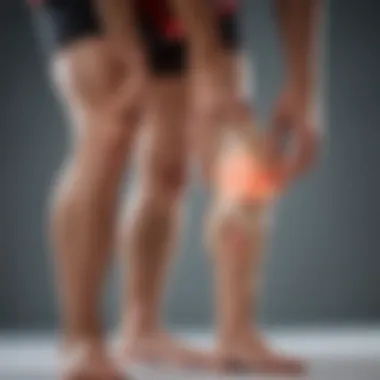Understanding Knee Osteoarthritis Pain and Management


Intro
Osteoarthritis (OA) is a chronic condition characterized by the degeneration of joint cartilage and the underlying bone. In the knee, this condition leads to significant pain and discomfort, impacting daily activities and overall quality of life. The understanding of osteoarthritis pain is multi-faceted, encompassing biological, psychological, and sociocultural dimensions. This article aims to provide a comprehensive exploration of the mechanisms behind knee osteoarthritis pain, its broader impacts on individuals, and potential management strategies.
Osteoarthritis primarily affects older adults, but it can also occur in younger individuals, particularly those with previous joint injuries. The prevalence of knee osteoarthritis continues to rise, correlating with an increase in risk factors such as obesity and sedentary lifestyles. In this piece, we will delve into how these factors influence pain pathways, the implications for social interactions, and how effective management can substantially improve patient outcomes.
Understanding the intricate nature of osteoarthritis pain requires a thorough examination of both pathophysiological mechanisms and the contextual factors influencing individuals experiencing this chronic condition. As we break down these elements in the following sections, readers will gain insight into the importance of integrated approaches for understanding and managing knee osteoarthritis.
Overview of Osteoarthritis
Osteoarthritis is a degenerative joint disease that primarily affects the cartilage in the knee. Understanding osteoarthritis is crucial as it significantly contributes to knee pain and functional impairment. This section emphasizes the need for thorough knowledge of the condition and its implications on individuals' lives. An informed understanding can lead to better management and improved quality of life for those afflicted. The details in this section set the groundwork for the subsequent discussions on mechanisms, symptoms, and management strategies.
Definition and Classification
Osteoarthritis is defined as a chronic condition characterized by the deterioration of joint cartilage and changes in the underlying bone. It is classified into two main categories: primary osteoarthritis, which occurs without any underlying condition, and secondary osteoarthritis, which results from previous joint injuries or other diseases. This classification helps in accurate diagnosis and treatment recommendations.
Key elements of osteoarthritis include:
- Cartilage wear and tear: The cartilage that cushions the bones gradually wears away, leading to pain and stiffness.
- Bone changes: As cartilage deteriorates, changes in the bone occur, such as the formation of osteophytes, which can result in pain and decreased joint function.
Epidemiology and Prevalence
Epidemiological studies show that osteoarthritis is highly prevalent, particularly among older adults. Research indicates that over 30 million adults in the United States are affected by osteoarthritis. Certain factors contribute to its prevalence:
- Age: The risk of developing osteoarthritis increases with age as mechanical stress on joints accumulates over time.
- Obesity: Excess body weight can cause additional stress on weight-bearing joints, particularly the knees.
- Previous Injuries: Past injuries to the knee, such as fractures or ligament tears, can elevate the likelihood of osteoarthritis developing later.
The impact of osteoarthritis extends beyond physical health; it also has economic implications. The healthcare costs associated with treating osteoarthritis are considerable, making effective management strategies vital.
Understanding the epidemiological patterns is essential for developing targeted public health interventions and resource allocation in the management of osteoarthritis.
Pathophysiology of Knee Osteoarthritis
Understanding the pathophysiology of knee osteoarthritis is crucial for comprehending the underlying mechanisms that lead to pain and dysfunction. It involves a complex interplay of biological, mechanical, and environmental factors. Recognizing these elements helps in identifying effective management strategies and developing targeted interventions to relieve symptoms and improve the quality of life for affected individuals.
Cartilage Degeneration
Cartilage serves as a cushioning material in joints. In knee osteoarthritis, cartilage degeneration is a significant factor that leads to pain and reduced mobility. Initially, the cartilage may show signs of wear and tear, which can evolve into fissures and extensive damage over time. This degradation impairs the joint's ability to absorb shock and distribute forces evenly during movement.
Studies indicate that cartilage degeneration is not simply a mechanical issue; it is also a biological process influenced by inflammation and cellular activity. Chondrocytes, the cells responsible for maintaining cartilage health, may become dysfunctional in osteoarthritis. This dysfunction incites additional breakdown of cartilage and results in the release of inflammatory mediators, further exacerbating pain and joint deterioration. A deeper understanding of this degeneration can guide therapies aimed at restoring cartilage integrity or slowing its decline.
Bone Changes and Formation of Osteophytes
As cartilage deteriorates, the underlying bone often starts to respond. Increased stress on the bone from the loss of cartilage leads to changes in its structure. The subchondral bone becomes denser but also weaker. This condition can foster the development of osteophytes, commonly known as bone spurs. These are bony projections that form along joint margins when cartilage is lost.
Osteophytes may contribute to pain and discomfort in knee osteoarthritis as they can impinge on surrounding tissues or nerves. The presence of these bony formations serves as a marker of advanced degenerative changes in the joint. Recognizing the role of osteophytes is significant because it could influence treatment choices, from pain management to surgical considerations.
Synovitis and Inflammatory Response
In knee osteoarthritis, synovitis plays a pivotal role in the pain experience. This condition refers to inflammation of the synovial membrane, which is responsible for producing synovial fluid that lubricates the joint. In osteoarthritis, inflammatory processes can lead to synovial thickening and increased fluid production, generating pain and swelling in the joint.
The inflammatory response in osteoarthritis is not merely an aftereffect of mechanical damage but is also characterized by the release of pro-inflammatory cytokines and other mediators. These substances propagate the cycle of inflammation and can sensitize pain pathways, markedly affecting the patient's pain experience.
Understanding synovitis in knee osteoarthritis is vital for developing therapeutic strategies that address not only the mechanical aspects of the disease but also its inflammatory components. Identifying effective anti-inflammatory approaches or modifying the inflammatory response can pave the way for improved patient outcomes.
Understanding the pathophysiology of knee osteoarthritis is essential for proper management and treatment planning.
Clinical Presentation of Knee Osteoarthritis


Understanding the clinical presentation of knee osteoarthritis is vital for various reasons. Clinicians use this knowledge to recognize the condition effectively. Insights into symptoms and functional impairments help in devising tailored management plans for patients. Moreover, accurate diagnosis and strong comprehension of the clinical picture impact patient quality of life considerably.
Symptoms: Pain and Stiffness
Knee osteoarthritis is primarily characterized by pain and stiffness. Pain can vary in intensity and is often worse after periods of inactivity. This pain usually worsens during physical activities, such as climbing stairs or walking long distances.
Stiffness is another prominent symptom. Patients often report feeling stiff in the morning or after sitting for a while. This stiffness can last for more than 30 minutes—a key indicator for osteoarthritis.
Patients may describe the pain as aching or throbbing. The discomfort may radiate to surrounding areas, affecting the hip or the lower back. Understanding these symptoms allows for better communication with healthcare providers, ensuring timely and appropriate interventions.
Functional Impairments
Functional impairments due to knee osteoarthritis manifest in several ways. They significantly inhibit a person's ability to perform daily activities, ranging from simple tasks like walking or standing to more demanding ones such as running or jumping.
Patients may struggle with balance and coordination due to reduced strength in the knee area. This limitation can lead to a fear of falling, prompting individuals to avoid physical activities. As such, there is a decline in overall fitness.
This decline extends beyond just physical limitations. It can lead to emotional distress, creating a cycle of frustration and decreased mobility. Addressing these functional impairments is crucial not only for physical health but also for emotional wellbeing.
Diagnostic Criteria
Diagnosing knee osteoarthritis involves a combination of clinical assessments and imaging techniques. The American College of Rheumatology provides widely accepted criteria for diagnosis. Key components include:
- Patient history: Detailed symptom description and the duration of knee issues.
- Physical examination: Assessing joint tenderness, swelling, and range of motion.
- Imaging studies: X-rays often reveal joint space narrowing, osteophytes, and subchondral sclerosis, which are common features of osteoarthritis.
To confirm a diagnosis, a healthcare provider must also rule out other types of arthritis or knee conditions that may present similarly. A thorough understanding of the diagnostic criteria empowers both patients and clinicians to act swiftly and appropriately in managing this chronic condition.
Pain Mechanisms in Osteoarthritis
Understanding the pain mechanisms involved in osteoarthritis is crucial. Pain is one of the primary symptoms that affects the quality of life for those dealing with knee osteoarthritis. Recognizing how pain develops can guide effective interventions. These pain mechanisms include nociceptive pathways, neuropathic components, and psychosocial factors. Each plays a distinct role in the experience of pain and, therefore, influences the approach to management strategies for osteoarthritis.
Nociceptive Pain Pathways
Nociceptive pain pathways are central to understanding knee osteoarthritis. Nociception refers to the nervous system's response to potentially damaging stimuli. In osteoarthritis, this often manifests as pain when the joint is subjected to pressure or movement. This type of pain arises from the stimulation of pain receptors found in the affected tissues like cartilage, ligaments, and synovium.
When these tissues undergo degeneration, they release inflammatory mediators. These mediators signal the nociceptors, projecting pain sensations to the brain. As the cartilage deteriorates, bones may rub against each other, causing friction and exacerbating pain signals.
Recognizing these pathways helps healthcare professionals effectively target the pain. For instance, medications like non-steroidal anti-inflammatory drugs (NSAIDs) focus on reducing the inflammatory process, thereby alleviating pain through this nociceptive channel.
Neuropathic Components
The role of neuropathic components in osteoarthritis pain cannot be overlooked. Although osteoarthritis is primarily nociceptive, patients may experience neuropathic pain. Neuropathic pain arises from damage to the nervous system, which can alter pain signaling.
In cases of knee osteoarthritis, chronic pain can lead to central sensitization. This condition means that the nervous system becomes more sensitive to pain signals. As a result, even non-painful stimuli might provoke pain, leading to a heightened experience of discomfort.
Studies suggest that neuropathic characteristics might contribute to the persistent pain many patients report. This insight underlines the importance of tailored treatment plans that address both nociceptive and neuropathic components.
Psychosocial Factors Influencing Pain
Psychosocial factors have a significant impact on pain perception in osteoarthritis. The experience of pain is not solely a physical sensation; it is influenced by emotional, social, and psychological contexts. For instance, anxiety or depression can amplify the perception of pain. Individuals who feel socially isolated may also report higher pain levels and diminished coping mechanisms.
Key psychosocial factors include:
- Coping strategies: How individuals manage their pain can affect its intensity. Effective coping can alleviate feelings of helplessness.
- Social support: A strong network can provide essential support, positively influencing pain management.
- Attitude and beliefs about pain: Positive attitudes can lead to improved outcomes, while negative beliefs may hinder recovery.
Understanding these factors is vital for healthcare providers. It allows for a comprehensive approach that addresses not only the physical aspect of osteoarthritis pain but also the psychological dimensions. Integrating pain management with psychological support can enhance the overall well-being of patients.
"The interplay between physical pain and psychosocial factors is critical to addressing the holistic needs of osteoarthritis patients."


In summary, the mechanisms of pain in osteoarthritis involve a complex interaction of nociceptive pathways, neuropathic conditions, and psychosocial influences. A clear understanding of these elements informs targeted management strategies, allowing clinicians to tailor their approaches for better patient outcomes.
Impact of Knee Osteoarthritis on Quality of Life
Knee osteoarthritis can have profound effects on an individual's quality of life. It is not just the physical pain; emotional and social aspects also play a significant role. A comprehensive understanding of these impacts is essential. The limitations in movement, changes in social interactions, and mental health challenges represent core elements that need examination. Addressing these impacts effectively can lead to improved outcomes for individuals.
Emotional and Psychological Considerations
The emotional toll of knee osteoarthritis is often underestimated. Individuals may face feelings of frustration, sadness, and helplessness due to their pain and reduced mobility. Managing knee osteoarthritis often requires more than just physical treatment; it also involves addressing psychological wellbeing. Studies indicate that individuals with chronic knee pain have a higher risk of conditions such as depression and anxiety.
Those diagnosed may also experience a sense of loss regarding their previous lifestyle. This may enhance feelings of isolation as activities they once enjoyed become difficult or impossible. The constant awareness of pain can lead to heightened stress levels.
Strategies to improve emotional support include:
- Counseling: Engaging with a therapist who specializes in chronic pain may help explore and address underlying feelings.
- Support Groups: Joining groups where experiences can be shared promotes understanding and reassurance among peers.
- Mindfulness Practices: Techniques such as meditation or yoga may provide relief from stress and improve mental health.
"The connection between mental health and chronic pain is complex, highlighting the need for comprehensive care."
Social and Economic Implications
Living with knee osteoarthritis can have significant social repercussions. Individuals may find it challenging to participate in social activities, leading to withdrawal from family and friends. Socializing and maintaining relationships can become burdensome due to mobility constraints and pain.
Economically, the implications are equally serious. The costs of managing osteoarthritis are substantial, encompassing direct medical expenses and indirect costs such as lost income due to inability to work. Family members might also bear financial strains due to caregiving demands, further complicating the situation.
In essence, the two main categories of implications are:
- Direct Costs: Medical treatments, therapy, and medications.
- Indirect Costs: Reduced income, job loss, and impacting family resources.
Finding methods to address these challenges is crucial. Approaching management from both emotional and social standpoints can aid in cultivating a better quality of life for individuals affected by knee osteoarthritis.
Management Strategies for Osteoarthritis Pain
Effective management of osteoarthritis pain in the knee is essential. It not only helps alleviate discomfort but also enhances functional capacity and improves quality of life. Deploying a combination of strategies allows for a tailored approach to treatment. Understanding the unique aspects of each method can aid in selecting the appropriate intervention for individuals.
Non-Pharmacological Approaches
Physical Therapy
Physical therapy plays a critical role in managing knee osteoarthritis pain. Therapists employ specific exercises to improve strength and mobility, targeting the muscles surrounding the knee. This is vital as stronger muscles help support the joint, reducing stress on damaged cartilage. One notable characteristic of physical therapy is its customized nature, adapting to each person's needs. Furthermore, physical therapy is non-invasive and carries minimal risk, making it a popular choice for many. The disadvantage lies in the need for regular sessions, which can be time-consuming and may depend on access to qualified professionals.
Occupational Therapy
Occupational therapy focuses on enhancing daily life activities for individuals with knee osteoarthritis. This approach emphasizes adapting tasks and using assistive devices to facilitate mobility and reduce strain. A key characteristic is the therapist's ability to tailor strategies to specific personal goals. It is a beneficial choice as it promotes independence and encourages participation in meaningful activities. A drawback, however, may be the reliance on equipment that some may find uncomfortable or difficult to use.
Lifestyle Modifications
Lifestyle modifications such as weight management, diet, and exercise habits are integral to effective osteoarthritis pain management. A significant aspect is that losing weight can decrease stress on the knee joints, leading to reduced pain and improved function. Adopting a healthier diet rich in anti-inflammatory foods can also benefit joint health. The advantage of lifestyle changes lies in their potential long-term impact. However, they require commitment and may take time to show significant results.
Pharmacological Treatments
Analgesics and NSAIDs
Analgesics, including non-steroidal anti-inflammatory drugs (NSAIDs), are commonly used to manage osteoarthritis pain. These medications help alleviate discomfort by targeting inflammation. A notable feature is their availability over-the-counter, making them easily accessible. They are a beneficial option for individuals seeking immediate relief. However, long-term use poses potential risks such as gastrointestinal issues or cardiovascular concerns.
Corticosteroid Injections
Corticosteroid injections serve as a direct intervention for managing localized knee pain. These injections reduce inflammation and provide relief for several weeks or months. An important characteristic of corticosteroid injections is their ability to provide rapid improvement in symptoms. This makes them a popular choice for those experiencing acute flare-ups. On the downside, repeated injections can lead to cartilage damage or other side effects over time.


Hyaluronic Acid Injections
Hyaluronic acid injections aim to restore joint lubrication, alleviating pain and improving function. This treatment is advantageous as it promotes the natural healing process within the joint, making it a beneficial method for some patients. Still, the efficacy may vary from individual to individual, and it may not be suitable for everyone, leading to mixed experiences among recipients.
Surgical Interventions
Arthroscopy
Arthroscopy involves a minimally invasive procedure to remove damaged tissue or debris from the knee joint. Its key characteristic is that it offers a quicker recovery compared to more invasive surgeries. This can lead to a faster return to daily activities. Arthroscopy is a good option for patients who have not found relief through conservative measures. However, it may not always resolve the underlying osteoarthritis and could necessitate further procedures.
Osteotomy
Osteotomy is a surgical procedure that reshapes the bones around the knee joint to relieve pressure on the damaged area. This technique can delay the need for total knee replacement. The unique feature is its ability to modify the alignment of the knee joint, thus providing benefit to younger patients or those who are less advanced in their disease progression. The downside is that recovery takes time and involves significant rehabilitation.
Joint Replacement Surgery
Joint replacement surgery involves replacing the damaged knee joint with a prosthetic implant. This procedure is a definitive solution for severe osteoarthritis and can dramatically improve quality of life. Its central feature is the high success rate in relieving pain. This surgery is a beneficial option to consider when other treatments have failed. However, it comes with inherent risks and a lengthy rehabilitation process.
In summary, the management strategies for osteoarthritis knee pain must be tailored to individual needs and circumstances. A holistic approach integrating both non-pharmacological and pharmacological treatments can provide optimal relief and improved function.
Future Directions in Osteoarthritis Research
Research on osteoarthritis (OA), particularly knee OA, is advancing rapidly. This progress is critical to improve understanding and treatment of this widespread condition. Addressing osteoarthritis effectively involves exploring fresh perspectives that can lead to innovative therapies and enhanced patient outcomes.
Emerging Therapies
Emerging therapies are pivotal in the ongoing effort to treat knee osteoarthritis more effectively. One area of intense investigation is biologic treatment options that leverage the body's own healing mechanisms. For example, stem cell therapy is being studied for its potential to regenerate damaged cartilage and reduce pain. This approach may offer hope for individuals who do not respond well to traditional management strategies.
Furthermore, platelet-rich plasma (PRP) injections are gaining attention for their ability to utilize growth factors that stimulate healing of tissues. Research evaluating different concentrations and methods of administration continues to evolve.
Another promising area involves gene therapy. Scientists are exploring how altering the expression of specific genes may slow the degeneration of cartilage. Though this field is still in its infancy, preliminary findings hold potential for novel interventions.
Genetic and Biomarker Studies
Genetic and biomarker studies are essential for understanding osteoarthritis's complex etiology. Researchers aim to identify genetic factors that predispose individuals to knee OA. This knowledge could help in developing targeted therapies customized to an individual's genetic make-up.
Biomarkers also play a significant role in improving diagnosis and monitoring of osteoarthritis. They can indicate disease severity, progression, or response to treatment. Advancements in imaging techniques and molecular diagnostics further support these efforts.
Identifying biomarkers may pave the way for strategic interventions tailored to the patient's specific condition. This focus on precision medicine enhances our understanding of the variability in osteoarthritis presentations and response to treatment.
"Emerging therapies and ongoing studies in genetics could fundamentally change the landscape of osteoarthritis management, offering patients new hope for effective treatment options."
In summary, the future directions in osteoarthritis research promise to enhance the understanding of the disease, leading to novel therapeutic strategies and improved patient care. Ongoing studies in emerging therapies, alongside genetic and biomarker investigations, represent a critical axis of osteoarthritis research.
Epilogue
The conclusion serves as a pivotal section in understanding the multifaceted nature of knee osteoarthritis. This article has explored various dimensions — from the underlying mechanisms of pain to the broader impacts on quality of life and management strategies. By synthesizing key insights, the conclusion reinforces the significance of recognizing osteoarthritis not just as a physical affliction but as a complex interplay of biological, psychological, and social factors.
The understanding of pain mechanisms, such as nociceptive pathways, and the influence of psychosocial elements are vital for clinicians and patients alike. This understanding enables more tailored management strategies that address not only the physical symptoms but also the emotional and social struggles associated with the condition. Furthermore, the ramifications of osteoarthritis extend beyond individual patients, impacting productivity and healthcare systems. Hence, acknowledging the comprehensive nature of this condition is crucial for effective interventions and support.
Summary of Key Insights
Key insights from this article include:
- Pathophysiology: A detailed understanding of cartilage degeneration, bone changes, and the role of inflammation in knee osteoarthritis is paramount.
- Impact on Quality of Life: The emotional and psychological implications highlight the importance of holistic treatment approaches.
- Management Strategies: Non-pharmacological, pharmacological, and surgical methods each play a critical role in managing osteoarthritis pain.
- Future Directions: There is a need for continuous research into emerging therapies and genetic factors to improve treatment outcomes.
These insights underscore the necessity for a comprehensive approach to osteoarthritis, urging clinicians to evaluate the patient's condition from all angles.
Call for Further Research and Awareness
Continued research into osteoarthritis is essential to advance our understanding of this complex condition. There are several areas that warrant further investigation:
- Emerging Therapies: Exploration of innovative treatment options, including gene therapy and regenerative medicine, will likely enhance current management practices.
- Psychosocial Studies: Comprehensive research aimed at understanding the psychosocial factors influencing patients’ pain and quality of life will be invaluable in developing supportive care models.
- Public Awareness: Increasing awareness of osteoarthritis within society will enable earlier diagnosis and improved management, leading to better patient outcomes.



